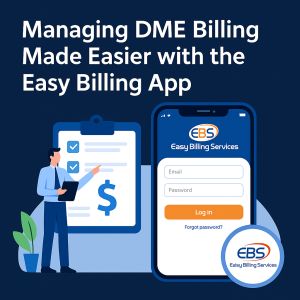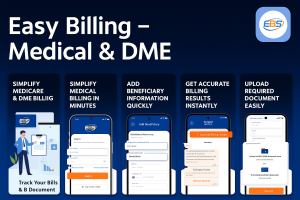Providers and billing specialists face difficulties involved in durable medical equipment (DME) billing. In today’s fast-paced era, a dme billing guide ought to be necessary for accurate billing, compliance, and maximum medicare reimbursements. This article presents a guide intended to help professionals highly charged with the responsibility of systematizing billing processes, revenue cycle optimization, and compliance with various rules and regulations.
Every aspect of DME billing services is discussed in this article: basic principles, medicare reimbursement processes, best practices, and trends. It is beneficial to those unfamiliar with this field as well as those in search of bettering practices already in use. You’ll see at the end how the steps to be undertaken in a structured dme billing guide might do wonders to improving your billing process and cutting down on costly errors.

Understanding The Basics Of DME Billing
Billing for durable medical equipment is surrounded by peculiar problems that are drastically different from other medical billing avenues. Before going into medicare reimbursements, it is good to understand the fundamentals of dme billing. Thereafter, a clear dme billing guide will provide a framework to help them navigate the minor details that make dme billing so complex by outlining the steps needed for accurate claims submission and timely reimbursement.
What is DME, and Why is It Important?
Durable medical equipment (DME) refers to supplies and equipment prescribed for long-term use by patients, such as wheelchairs, oxygen equipment, hospital beds, etc. Because of their high intrinsic value and critical nature, getting billing right is a top priority. Billing errors can lead to late payments, claim denials, or audits from regulatory authorities.
- Patient Eligibility: Ensuring that the patient’s plan of Medicare or insurance will cover the required dme.
- Physician Certification: Proper documentation and prescriptions are secured.
- Claim Submission: Claims are coded correctly and submitted within specified periods.
- Follow-Up: Any denials or resubmissions and appeals are managed.
A structured dme billing guide not only makes these easier but will also provide education on compliance requirements and billing irregularities concerning DME.
The Role of Technology in DME Billing
Recent technological advancements in health care have changed the perception of DME billing. Automated billing software and electronic health records (EHR) can significantly minimize manual errors and hasten the entire procedure. The integration of these technologies with a robust billing guide will enable organizations to streamline operations, reduce administrative burdens, and eventually aim toward improved patient care with financial gain.
Medicare Reimbursements for DME Providers
It is important to understand Medicare’s rules and regulations to remain in compliance and ensure financial stability.
Key Elements of Medicare Reimbursements
Medicare has strict guidelines regarding which items are reimbursed and the documentation necessary for claims to be honored. Providers must stay on top of changes to reimbursement rates, coverage, and documentation policies. A good dme billing guide will make sure that each claim submitted follows these guidelines and minimizes the chance of denial.
Documentation and Coding Standards
Proper documentation and coding are core to billing Medicare successfully. The provisions of each claim contain the type of equipment furnished, the diagnosis made by the patient, and the physician’s order. Coding errors and incomplete documentation result in a claim rejection, delaying payment and straining the provider’s finances.
In order to be saved from this disaster, it is advisable to implement a clear and consistent dme billing guide that gives importance to accuracy at every step, from patient consultation to claim submission. This not only reduces the number of errors but also establishes reliable future auditing and reviewing records.
Best Practices in DME Billing Guide
It has been demonstrated that the best practices in DME billing will lead to major improvements in claim accuracy. Here are those strategies, many of which will work for the provider:
Standardize Your Billing Process
Standardization is key. The dme billing guide includes detailed explanation of every step, ensuring that all team members will adhere to the same methods. Such standardization would cause an evident reduction in variability and enable the treatment of every single claim in the same manner.
Invest in Training and Education
A billing audience must undergo training aimed at sharpening their skills in catching up with the most recent changes in policies, coding, and best practices. Train your team to add real-world scenarios and case studies in order for participants to appreciate how the guidelines established in their dme billing guide may apply to the few varied situations.
Monitor and Audit Your Claims Regularly
Frequent award-reviewed audits and monitoring of claims may assist in unearthing an ongoing error or inefficiency. A comparison of your processes with your dme billing guide enables you to easily review the many areas for improvement and implement corrective action before minor problems become major headaches.
Durable Medical Equipment Billing Guide
Moreover, many organizations draw upon a durable medical equipment billing guide, which has beyond-the-face value but provides in-depth insights into the entire billing process. This usually includes a discussion of the most complex situations, checklists, and tricks for handling usual traps, guaranteeing that your approach is always comprehensive and current.
Implementation Strategies for a Successful DME Billing Process
Successful implementation of DME billing processes requires careful design, the right tools, and ongoing improvement. Understanding what is DME process in medical billing is crucial. It involves accurately submitting and reimbursement of durable medical equipment claims through proper coding, documentation, and compliance with medicare regulations. Following these steps helps streamline billing and prevent reimbursement delays.
1. Assess Your Current Workflow
Before you can do all that, you must evaluate your particular billing practices. What are the inefficiencies or sources of frequent error? Compare your workflow with the recommendations in a billing guide and find areas for improvement.
2. Integrate Advanced Billing Software
Modern billing software can automate many steps in the entire dme billing process, including, but not limited to, claim creation through submission and follow-up for doctors. All these systems are made to run along the structured steps of a billing guide and make everything processed accurately and efficiently.
3. Collaborate with Experts
You can also work with billing specialists or consultants who are into DME. These professionals tend to have better insights into the guidelines as well as humanize your processes to become specific with the requirements under Medicare. Things usually happen with such experience and within a short period.
4. Implement Regular Training and Updates
Medicare reimbursements are regularly changing as a result of regulations. Build a routine of informing your billing team any time policy changes or best practices have changed. Periodically enforced through refresher courses, it prevents costly mistakes and ensures compliance through the very lines outlined in a dme billing guide.
5. Establish Clear Communication Channels
Establish a clear system for all team members to share messages, ask questions, or report issues. This collaborative environment, nurtured by a clear billing guide, promotes transparency, as issues are addressed as they arise.
Future Trends and Innovations
The environment of DME billing, along with other changes in the healthcare arena, will continue to evolve with new advances and developments in Medicare reimbursements. Therefore, it is important to watch future patterns to find ways to improve your organization’s position over time and remain competitive.
Embracing Digital Transformation
Artificial intelligence and machine learning are making people brighter and far more effective. Future billing software can even predict an imminent problem in a claim when incorporated as real-time feedback in a billing guide.
Patient-Centric Billing Practices
Patient expectations are transforming, creating a need for simpler and clearer billing modes. The trends of the future will lean toward laws that are more patient-friendly regarding billing, where all information on the charges is clear, precise, and accurate.
Final Verdict
In conclusion, effectively handling the intricacies of Medicare reimbursements and billing for durable medical equipment requires a very strategic and detail-oriented approach. Effective use of an extensive dme billing guide helps providers navigate complex requirements for documentation, coding, and compliance, as well as ensuring prompt reimbursement. Adding high technology, ongoing training and retraining of staff, and periodic review of procedures, all backed by expert assistance from durable medical equipment billing services, is really the core of any successful billing operation. By keeping within these parameters, healthcare providers can reduce claim denials and optimize their revenue cycle in an employable operational setting, which is changing so fast with respect to regulation. Simplify your DME billing with Easy Billing Services LLC®. Boost revenue, minimize denials, and ensure compliance with the latest regulations.
Contact Us Today:
Call: 877-306-2906
Email: info@easybillingservices.com
Frequently Asked Questions
What is a DME billing guide?
It’s a step-by-step resource for accurate DME billing and compliance.
Why use durable medical equipment billing services?
They offer expert support to optimize claims and ensure timely reimbursements.
What are the key steps in DME billing?
Verify eligibility, secure documentation, code accurately, and submit claims on time.
How can I reduce claim denials?
Follow a clear billing guide, use technology, and conduct regular audits.
How does technology improve DME billing?
It automates tasks, minimizes errors, and streamlines the billing process.









